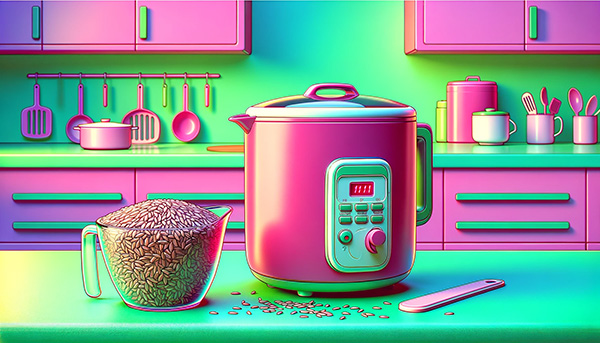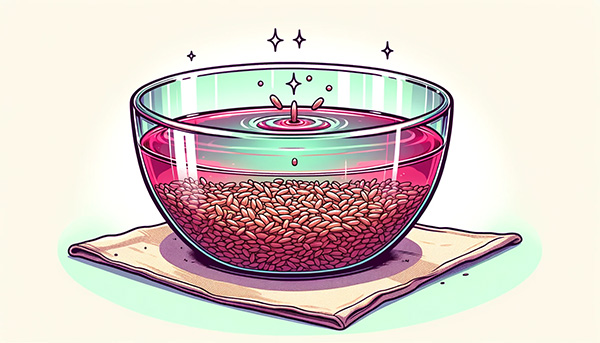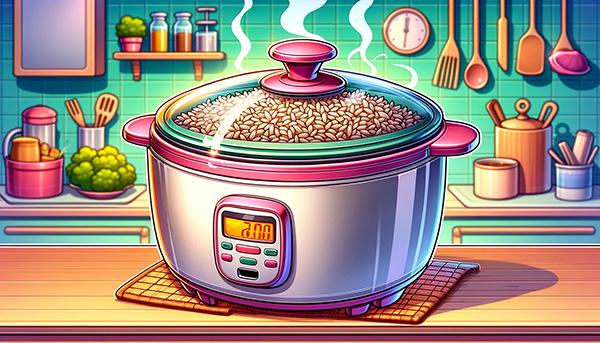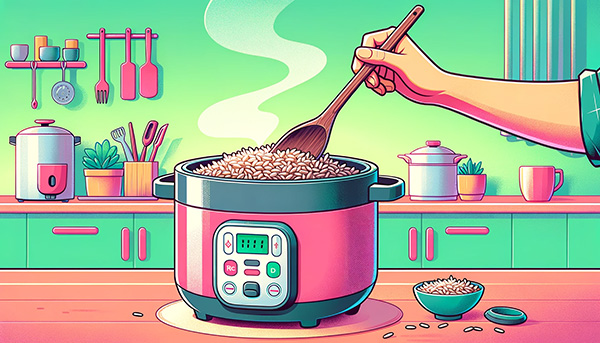In the world of nutritious and wholesome grains, brown rice reigns supreme. Bursting with fiber, vitamins, and minerals, brown rice offers a wealth of health benefits that are simply hard to ignore. However, cooking this nutrient-packed grain to perfection can be challenging, often leading to uneven textures and flavors that don't quite hit the mark. But fear not, cooking brown rice in a rice cooker just got easier!
Whether you're a seasoned home cook or just starting your culinary journey, the rice cooker is an indispensable tool for achieving fluffy, perfectly cooked brown rice with minimal effort. No more worrying about undercooked or overcooked rice, as the rice cooker takes the guesswork out of the equation, leaving you with consistent results every time.
In this post, we'll explain everything you need to know to cook perfect brown rice in your countertop rice cooker.
How Is Brown Rice Different From Other Rice Types?
There are thousands of different types of rice in the world, with brown rice standing out as one of the prevalent types. This variety is classified as a whole grain, signifying that every grain component is retained. This contrasts with white rice, which removes the bran and germ (and, as a result, loses much of its nutrients). Brown rice, like most whole grains, cooks up into a chewy texture and nutty flavor. It also typically takes longer to cook than its white rice counterpart.
Brown rice is a large category, however. Numerous variations of brown rice exist, including long-grain brown rice, short-grain brown rice, brown jasmine rice, and brown basmati rice. Short-grain brown rice will generally be slightly stickier (somewhat like sushi rice). Long-grain brown rice displays lower stickiness and boasts more discernible individual grains. It's the preferred rice for fried rice recipes.
The Water-To-Rice Ratio For Perfect Brown Rice
Cooking brown rice is all about the proper water ratio. If you add too much water to your rice cooker pot, your rice will come out in a slurry. Adding too little will make the rice grains overly chewy and hard.
The best brown rice recipe for cooking in a rice cooker is to use 1 cup of water to 2 cups of uncooked rice. This proportion is effective when using a rice cooker, instant pot, or stove-top pan. However, there will be slight variations in the types of brown rice.
Here are the approximate water-to-rice ratios for different types of brown rice when cooking in a rice cooker.
Long Grain Brown Rice: 2 cups water for 1 cup of rice
Medium Grain Brown Rice: 1.75 to 2 cups water for 1 cup of rice
Short Grain Brown Rice: 1.5 to 1.75 cups water for 1 cup of rice
Basmati Brown Rice: 1.75 to 2 cups water for 1 cup of rice
Jasmine Brown Rice: 1.75 to 2 cups water for 1 cup of rice
Wild Rice Blend (With Brown Rice): 2 to 2.5 cups water for 1 cup of rice blend
How To Cook Brown Rice In Rice Cooker
Cooking brown rice in a rice cooker is incredibly straightforward! Although rice cookers may seem intimidating to someone used to a pot on the stove, their "set it and forget it" quality will have you reaching for them time and again. Here's how to use your rice cooker to make delicious brown rice.
1. Measure And Rinse The Rice

Take a measuring cup and measure one cup of brown rice. Next, rinse the rice under cold tap water until the water runs clear.
2.Soak The Rice (Optional)

Put the rinsed rice into a bowl and submerge it in water, ensuring the water level is 2-3 inches higher than the rice. Optionally, include a tablespoon of lemon juice or vinegar in the water, as these acidic agents can assist in breaking down phytic acid. Allow the rice to soak for a minimum of 6 hours or overnight. Some sources recommend soaking for up to 24 hours for maximum benefits.
After soaking, drain the excess water and rinse the rice under cold water again before cooking. Once the rice is properly drained and rinsed, introduce it into the rice cooker.
3. Add Water
For each rice cup, measure 1 1/2 cups of water and add it to the rice in the rice cooker pot. If desired, a small pinch of salt can be added to the water.
4. Switch On The Rice Cooker And Choose Your Setting

Depending on the specific model of your rice cooker, you may have a single power switch without any additional options. In that case, simply flip the switch and let it cook! Otherwise, consult your rice cooker manual to choose the right setting.
Your rice cooker may have a specific brown rice setting! Once your setting is selected, keep the lid closed as it cooks to retain the steam. The rice cooker will notify you when it reaches the end of the cooking time, typically with a beep or light indicator.
5. Let The Rice Rest

Once the rice cooker signals the end of the cooking cycle, allow the rice to rest with the lid closed for 10-15 minutes. This allows the rice to absorb the steam, enhancing its texture.
6. Fluff It Up

Once the resting time has elapsed, uncover the rice cooker and delicately fluff the rice using a fork or wooden spoon. This action will separate the grains and ensure they become light and airy. Utilize the nutritious brown rice as a foundation for a range of dishes, or enjoy it as a side dish.
Tips For Cooking Brown Rice In a Rice Cooker
Adjust Water-to-Rice Ratio
The standard water-to-rice ratio for brown rice is usually 1.5:1 (1.5 cups of water for 1 cup of rice). However, different types of brown rice and rice cooker models may require slight adjustments. Follow the guidelines outlined in your rice cooker's manual or the instructions on the rice packaging.
Soaking (Optional)
Pre-soaking brown rice for several hours before cooking can aid in diminishing cooking duration and enhancing digestibility. If you soak, reduce the amount of water used in the cooking process to compensate for the absorbed water.
Don't Open the Lid
Once you initiate the cooking cycle, avoid opening the rice cooker's lid until the cycle is finished. Opening the lid during this time can disturb the cooking process and impact the rice's ultimate texture.
Fluff Gently
Use a fork or wooden spoon to fluff the cooked rice delicately. Refrain from vigorous stirring, as it can cause the rice grains to break and result in a mushy consistency.
Keep Warm Setting
If you're not ready to eat immediately after the cooking cycle, use the rice cooker "keep warm" setting. However, it's best to refrain from leaving the rice in the "keep warm" setting for prolonged durations, as this can influence its texture.
How To Elevate Brown Rice Recipe In Your Rice Cooker
Infused Broth: Instead of using plain water, cook your brown rice in vegetable or chicken broth. This process imparts savory flavors to the rice and develops a more indulgent taste profile.
Aromatics: Elevate the flavor of your rice by introducing aromatic elements such as minced garlic, finely chopped onions, or grated ginger. Give them a quick sauté before adding the rice and water to the rice cooker.
Coconut Milk: For a tropical twist, substitute some water with coconut milk. This will lend the rice a creamy texture and subtle coconut flavor.
Fresh Herbs: Mix in chopped fresh herbs like cilantro, parsley, or chives after cooking the rice. Herbs can provide a burst of freshness and color to your dish.
Citrus Zest: Add a vibrant zing to your rice by stirring in freshly grated lemon, lime, or orange zest. This technique is particularly effective when preparing dishes that include seafood or poultry.
Toasted Nuts: Roasted nuts like almonds, cashews, or pine nuts can contribute a delightful crunch and a hint of nutty flavor to your rice. Simply scatter them over the cooked rice before serving.
Dried Fruits: Incorporate dried fruits such as raisins, cranberries, or apricots to introduce a sweet and chewy contrast to the nutty brown rice.
Spices and Seasonings: Explore various spices and seasonings to craft distinctive and unique flavor profiles. Consider options like curry powder, cumin, turmeric, or smoked paprika for a twist.
Sautéed Vegetables: Sautéing vegetables like bell peppers, peas, carrots, and corn before adding them to the rice cooker can provide added texture and flavor.
Protein Additions: To enhance the nutritional value of your dish, stir in cooked protein sources like grilled chicken, shrimp, tofu, or beans.
Sauce Drizzle: Serve your cooked brown rice with a drizzle of your favorite sauce, whether a tahini-based dressing, soy sauce, or a homemade vinaigrette.
Garnishes: Elevate the presentation of your rice by adding visually appealing garnishes like sliced scallions, toasted sesame seeds, or microgreens.
Drizzle of Oil: Before serving, drizzle high-quality olive oil or toasted sesame oil over the cooked rice. This imparts flavor and gives the rice a glossy finish.
FAQs
Do I Need To Rinse Brown Rice?
Absolutely yes, you need to rinse uncooked rice! You need to rinse all the rice! This is for many reasons. Primarily, it washes away the exterior build-up of starch that tends to form when rice sits in its packaging. When cooking, leaving this extra starch on the rice will result in gummy, gluey rice. Rinsing removes any residual chemicals from the farming process as well. To wash the rice, rinse it in cold water until it clears. You might have to repeat this rinsing process more than once.
How Do I Keep Brown Rice From Sticking?
Certain rice varieties, like short-grain rice, are intentionally designed to have a "sticky rice" texture. The sticking we're talking about here is how to prevent the rice from sticking to your machine! Rinsing the rice beforehand will help. You can also coat the rice cooker with a small amount of oil or add that oil directly to the water. Alternatively, you can use a rice cooker napkin, which is a reusable cloth that sits directly inside your rice cooker and keeps the rice from touching the rice cooker directly.
How Long Does It Take Brown Rice To Cook?
Brown rice requires a longer cooking time than white rice. If your rice cooker operates using a timer you can set, you may wonder how long you should set it for! In most rice cookers, a cup of brown rice typically takes around 45 minutes to an hour on the "normal" setting to achieve a perfectly fluffy texture. However, the best place to look is the cooking instructions in the user manual for your specific rice cooker!
Can I Open The Lid While The Rice Cooks?
No! The trapped steam is critical to cook the rice! You may be tempted to open the lid and "check in" on your rice as it cooks, but doing so will result in undercooked rice.
Can I Use The Same Water-To-Rice Ratio For Different Types Of Brown Rice?
Various types of brown rice, such as long, medium, and short grain, have slightly varying water needs stemming from differences in size and starch content. It's crucial to adapt the water-to-rice ratio for each specific type.
Do I Need To Soak Brown Rice Before Cooking It In A Rice Cooker?
While soaking brown rice is not obligatory, it can be beneficial in terms of shortening cooking time and enhancing digestibility. Remember to slightly adjust the water-to-rice ratio if you opt for soaking, as soaked rice tends to absorb some water.
Can I use the "White Rice" setting To cook brown rice in a rice cooker?
Yes, you can use the "White Rice" setting to cook brown rice in numerous rice cookers. The "White Rice" setting often provides suitable results for various types of rice, but you may need to adjust the water-to-rice ratio slightly.
How To Store Leftover Rice
To store leftover rice safely, cool it quickly within an hour of cooking to prevent bacterial growth. Transfer the cooled rice to an airtight container and refrigerate it, where it can be kept for up to 4-5 days. For longer storage, freeze the rice in airtight bags or containers, lasting up to two months. Thaw and reheat it thoroughly before consumption to ensure safety and restore its texture.

